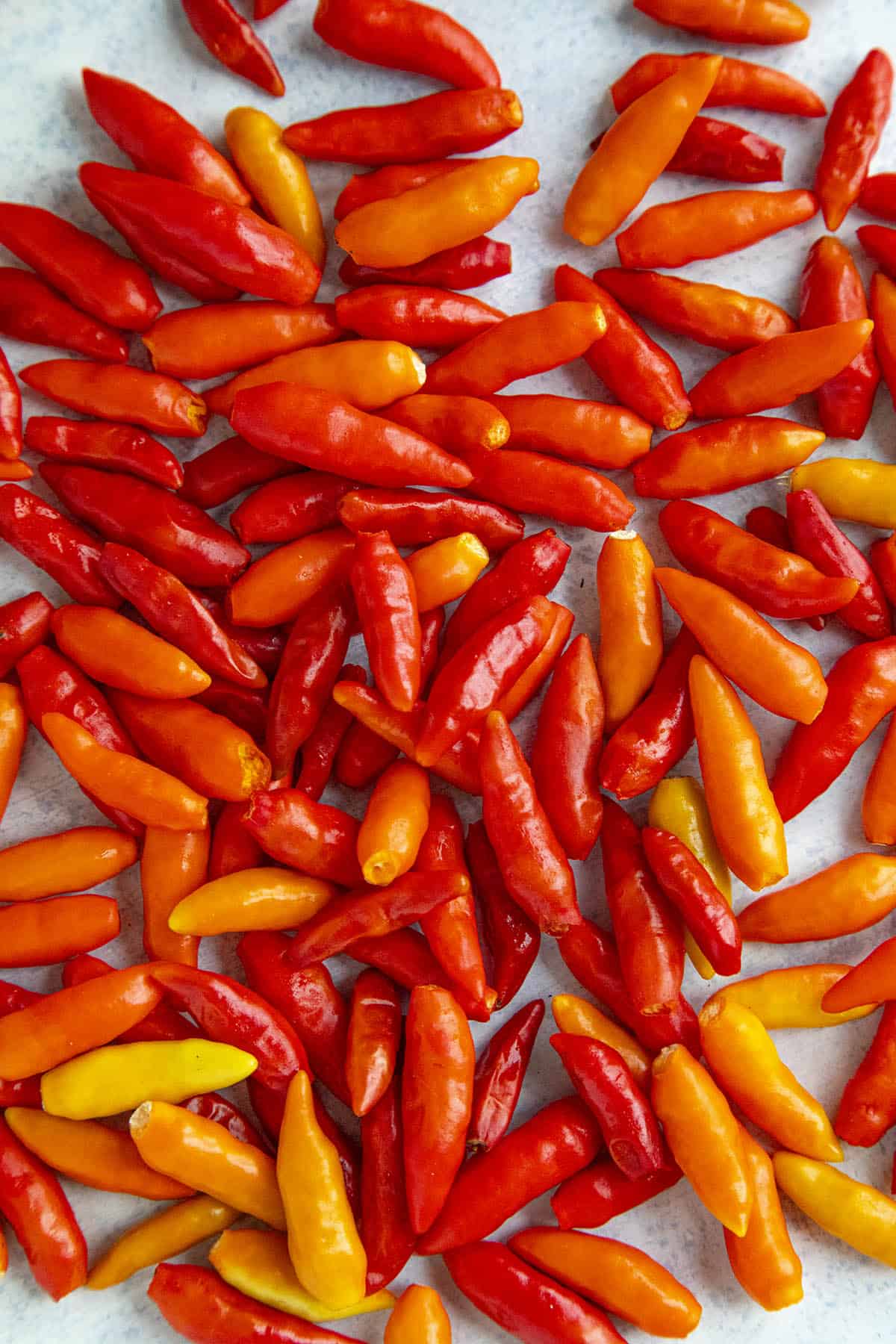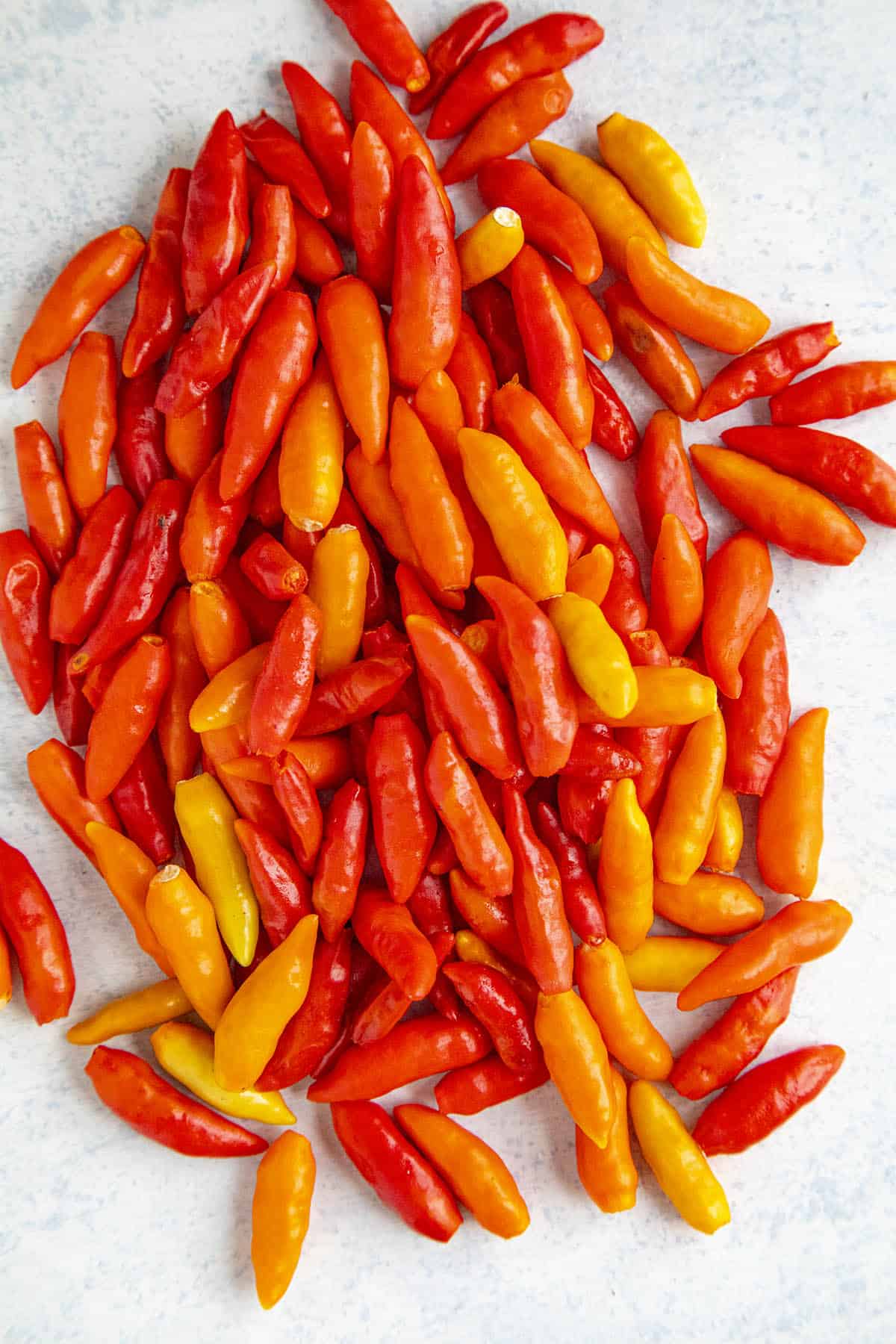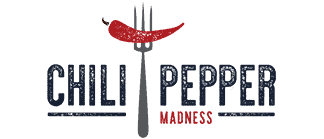The tabasco pepper is a chili pepper originating from Mexico, best known for being used to make the famous Tabasco sauce. The peppers are vibrant red and offer a nice level of heat. Learn more about them.

Scoville Heat Units: 30,000 - 50,000 SHU
Capsicum Frutescens
The tabasco pepper is a variety of the chili pepper species Capsicum frutescens, like the Naga Jolokia. It's a very pungent pepper grown mostly in the Gulf Coast states and Mexico. It is mostly known as the pepper used to make the very famous hot sauce, Tabasco sauce. It's one of the most well known peppers next to the jalapeno pepper.
Origin of the Tabasco Name
The word, "tabasco", is the name of a state in Mexico. The name of the pepper came first, which was later adopted by the famous hot sauce by McIlhenny Co.
Tabasco Pepper Appearance
The fruit is tapered and usually grow under 2 inches long. The color is usually creamy yellow to red, and turn yellow and orange before ripening to a vibrant, bright red. You can see the wonderful colors from these pods that I picked from my own garden.

How Hot is the Tabasco Pepper?
Tabasco peppers range in heat from 30,000 to 50,000 Scoville Heat Units on the Scoville Scale. Compare that to an average jalapeno pepper, which averages in at 5,000 SHU and you'll find the tabasco is 6-10 times hotter. They are more comparable to the popular cayenne pepper in heat and also flavor. It is quite a hot pepper.
Tabasco sauce, the brand hot sauce, measures in much lower, at 2,500 to 5,000 SHU.
Growing Tabasco Peppers
Tabasco pepper plants can reach a height of up to 5 feet tall (60 inches/1.5 m), though smaller plants are more normal. They’re very productive plants, holding many pepper pods at one time. The peppers start out green, then turn yellow green and ripen to bright orange then vibrant red. Peppers usually can be picked 80 days after germinating.
They grow better in warmer temperatures, above 75°F (24°C), and in well-drained soil with a pH between 5.5 and 7.5. They have a low tolerance for frost, as do most chili pepper plants.
Tabasco pepper plants are somewhat bushy, though you can trim them back as needed to accommodate room for your other pepper plants.
Personally, I have grown tabasco peppers for a few years and highly recommend them, though they prefer warmer temperatures and full sun. Grow them in a sunny location if you are able. The plants are always very productive and produce fruit, and they’re easy to grow in a simple home garden. I have a great growing season last year with lots of pods produced, and I am currently in zone 5, where temperatures don't always stay consistent and warm overnight.
I love making my own homemade Tabasco sauce with them, and cooking with them in general.
Can You Pick Green Tabasco Peppers?
Yes, you can pick these peppers when they're still green, but they are much better when they mature and turn bright red or orange-red. They are sweeter and fruitier with a much better overall flavor when they have ripened. However, if it is the end of the season and you are concerned about frost, then it is best to pick them green and attempt to finish ripening them indoors or use them to make a salsa verde or cook them into other meals.
Learn how to ripen unripe peppers indoors.
Tabasco Pepper Weights & Measurements
How Much Does a Tabasco Pepper Weigh? An average tabasco pepper weighs about .04 ounce, or 1.2 grams.
How Many Tabasco Peppers Per Pound? There are roughly 24-24 average sized tabasco peppers per ounce, and 100 tabasco peppers per pound.
What to do with Tabasco Peppers
My favorite ways to cook with tabasco peppers are for making fresh salsa, making homemade tabasco hot sauce, and dehydrating them to make spicy tabasco chili powder. These peppers make a great salsa roja that is nice and spicy and great for game day gatherings, parties and other events.
For making hot sauce, I make fermented and non-fermented versions and love them both. I usually keep it simple and include nothing but tabasco peppers, vinegar and a bit of salt. Very tasty! They make an outstanding Louisiana style hot sauce.
Dehydrating is simple, as I use a dehydrator. I usually leave them to dry overnight until they are very dry and brittle, then grind them into powders for use as a seasoning. Learn more about how to dehydrate chili peppers for making chili powders here.
They're also good for general cooking. I often chop some and freeze them, cook use them to cook down with onions and celery as a base for soups, stews and other sauces with a bit of a kick to them. I do like my foods spicy.
Where to Buy Tabasco Products, Plants and Seeds
Purchase tabasco sauce or purchase tabasco seeds other products at Amazon (affiliate link, my friends). You can also check out my chili pepper plants and chili pepper seeds resources pages.
Try making your own Homemade Tabasco Sauce!
Got any other questions? Drop me a line anytime. I'm happy to help.
NOTE: This post was updated on 1/27/20 to include new information and photos. It was originally written on 9/23/13.


Retha Thomas says
How do you measure the ounces of peppers?
Mike H. says
Retha, you can measure by weight (using a kitchen scale, for example) or by volume. Hope it helps!
Sasquatch65 says
Making the non-fermented version today
Mike Hultquist says
Enjoy!
Ed Dolensky says
Mike, thanks for your helpful information.
My goal is to use tabasco peppers to make a traditional Louisiana hot sauce (fermented) but I have only a few plants so as I harvest weekly it takes a while to get a lot of peppers. I've been leaving them out flat on a tray and they dry/shrivel up. They also tend to darken as they dry. Do I have to hydrate them in hot water when I'm ready to process a batch? Or should I freeze the newly harvested peppers and thaw them all when I'm ready to process? Either method better than the other? Your great articles/videos use fresh peppers and I just don't have number of plants to do that.
Mike Hultquist says
Thanks, Ed. Yes, they will darken a bit if you dry them, and you'd need to rehydrate them in hot water (or with warm vinegar) for making hot sauce. You can also freeze them, then thaw and process. One method I like to do is finely chop them and store them in a container in the fridge with a bit of vinegar to keep them longer as I wait for more peppers to harvest. I'll be using vinegar in the hot sauce anyway, so there is no flavor issues. I hope this helps!
Trevor Beckett says
I have heard that these chilli peppers have distinct enemies with other plants. what can't you plant with or near them please
Mike H. says
Hey Trevor, you would normally avoid planting tabasco peppers next to beans, kohlrabi, cabbage, fennel, onions, garlic and potatoes.
Thomas Wagner says
I live up north and ferment my own hot sauce I would love to make Tabasco sauce but can not find any place that sells Tabasco peppers. Do you know of any place I could purchase them?
Mike H. says
Well, it can be challenging. But I would go through the following options: online seed retailers, local farmers' markets, pepper enthusiast groups, specialty food stores, Amazon... Let me know where you will be able to finally get them from.
Lee says
Perhaps harvest whole branches with unripe fruit and hang ripen indoors. Most peppers do not know their branch has been separated and will continue to ripen.
Mike Hultquist says
Yes, this works. I can confirm.
Michael Bailey says
Can you make a Tabasco pepper oil from these? Olive oil, avocado oil?
Mike Hultquist says
Absolutely, Michael. See my post on How to Make Chili Oil: https://www.chilipeppermadness.com/cooking-with-chili-peppers/how-to-make-chili-oil/
Howard Hughes says
Once you pick the peppers is the plant finished or does it reproduce annually?
Mike Hultquist says
Much depends on your climate. Tabasco plants usually go dormant in the winter and can be over wintered, but in ideal warmer climates, pepper plants can keep producing, as they are perennials.
Howard Hughes says
Thanks for the info, so once they are red, I can pick them? Although they are about an inch long?
Mike Hultquist says
Yes, you can pick them. That's pretty normal size.
Christina says
This is our first time growing Tabasco peppers. When they are green, they are firm. We’ve noticed that when they turn red they soften. Is this the way they are supposed to be, or are you supposed to use firm red Tabasco peppers when canning sauce?
Mike Hultquist says
Christina, the red tabasco peppers should be firm as well. It could be they are ripening and going bad on the plants (getting too soft, rotting). It's possible you need to pick them sooner, or there is an issue, such as heat or not enough nutrients.
Darlene R. says
My Tabasco plants have black peppers. Why didn't they start out green??
Mike Hultquist says
Possibly the wrong plant? Or a strain/hybrid of tabasco?
Nancy Kimberly says
Thank you for this amazing resource. With the high temperatures this summer in South Louisiana we only got mostly hot peppers thriving in our garden. I am desperate to preserve them.
Mike Hultquist says
Glad to help, Nancy. Good luck with the harvest.